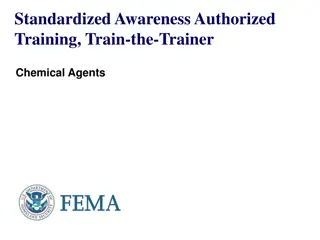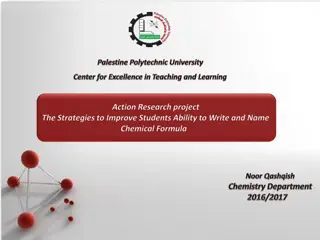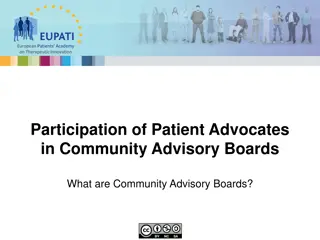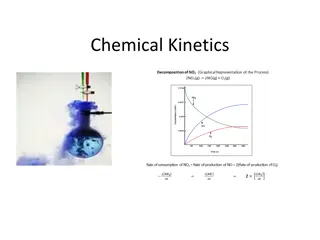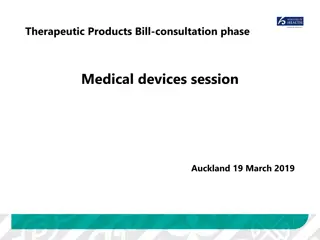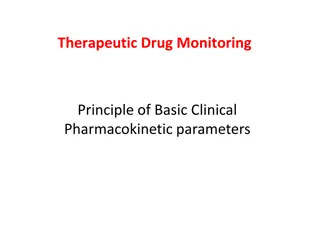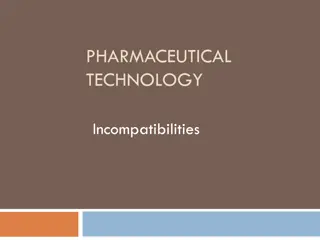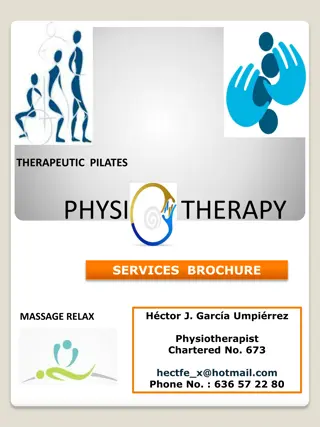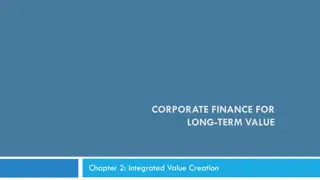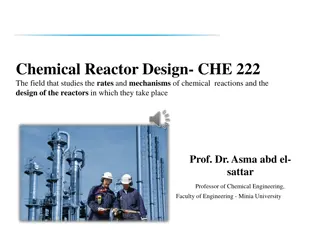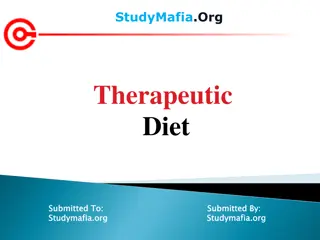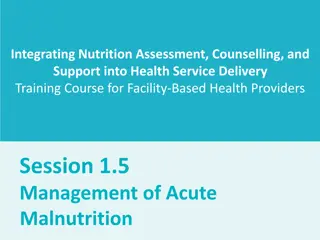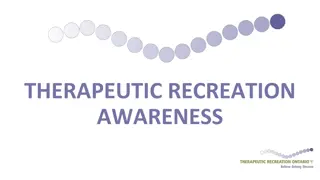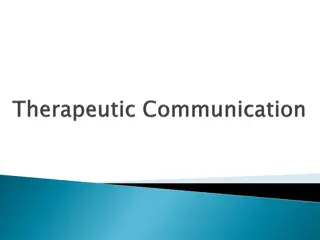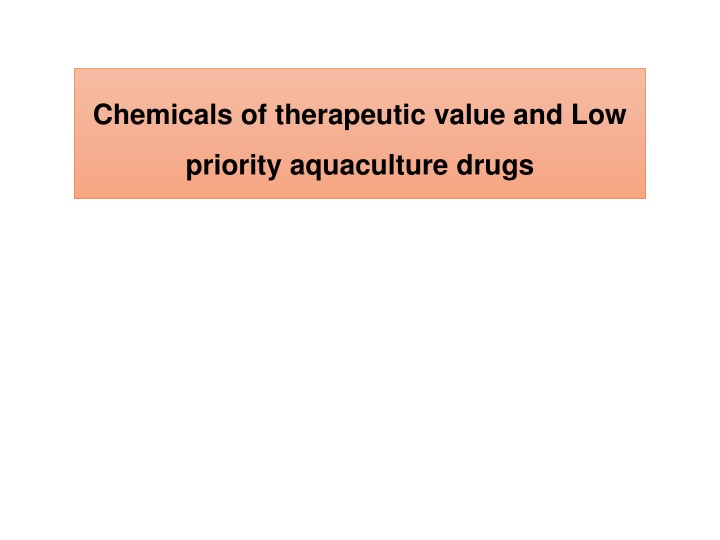
Therapeutic Value of Chemical Compounds in Aquaculture Drugs
Explore the significance of chemicals in aquaculture drugs, including their therapeutic value and sources from plants, insects, and more. Learn about compounds like rotenone and saponins, their natural sources, and their applications in medicine and agriculture.
Download Presentation

Please find below an Image/Link to download the presentation.
The content on the website is provided AS IS for your information and personal use only. It may not be sold, licensed, or shared on other websites without obtaining consent from the author. If you encounter any issues during the download, it is possible that the publisher has removed the file from their server.
You are allowed to download the files provided on this website for personal or commercial use, subject to the condition that they are used lawfully. All files are the property of their respective owners.
The content on the website is provided AS IS for your information and personal use only. It may not be sold, licensed, or shared on other websites without obtaining consent from the author.
E N D
Presentation Transcript
Chemicals of therapeutic value and Low priority aquaculture drugs
Chemical Chemical is a distinct compound or substance, especially one which has been artificially prepared or purified or extracted from natural sources. Compound: Thing consisting of several parts or elements. Elements are chemically the simplest pure substances (made up of one types of atom) which cannot be broken down into another substances.
Therapeutic Therapeutic is a branch of medicine that is concerned specifically with the treatment of disease. Sources of Therapeutic chemical compound Therapeutic agents are obtained from 6 major sources- 1. Plants sources 2. Animals sources 3. Minerals or Earth sources 4. Microbiological sources 5. Synthetic sources 6. Recombinant DNA technology
Plant sources All most all parts of the plant are used- stem, leaves, bark, fruit and root. Leaves: The leaves of Digitalis purpurea are the source of Digitoxin and Digoxin, which are cardiac glycosides. Leaves of Eucalyptus gives oil of Eucalyptus, which is important component of cough syrup. Tobacco leaves give nicotine.
Rotenone Insecticide, piscicide, and pesticide. It occurs naturally in the seeds and stems of several plants, such as the jicama vine plant, and the roots of several members of Fabaceae plant. Rotenone is produced by extraction from the roots and stem Rotenone works by interfering with the electron transport chain in mitochondria. Rotenone also inhibits microtubule assembly.
Saponin Saponins are glucosides with foaming characteristics. Saponins consist of a polycyclic aglycones attached to one or more sugar side chains. The foaming ability of saponins is caused by the combination of a hydrophobic (fat-soluble) sapogenin and a hydrophilic (water-soluble) sugar part. Saponins have a bitter taste. Saponins toxin are known as sapotoxin.
The best known sources of saponins are peas, soybeans, and some herbs with names indicating foaming properties such as soapwort, saoproot, soapbark and soapberry. Commercial saponins are extracted mainly from Yucca schidigera and Quillaja saponaria. Quillaja saponaria Yucca schidigera
Animal sources Pancreas is a source of Insulin, used in treatment of Diabetes. Urine of pregnant women gives human chorionic gonadotropin (hCG) used for treatment of infertility. Sheep thyroid is a source of thyroxin, used in hypertension. Cod liver oil is used as a source of Vitamin A and D. Blood is used in preparation of vaccine.
Mineral sources Iron is used in treatment of iron deficiency anaemia. Zinc is used as zinc supplement. Zinc oxide paste is used in wounds. Iodine is antiseptic. Iodine supplement are also used in diet. Fluorine has a antiseptic properties. Selenium sulphide is used in anti dandruff shampoos.
Synthetic sources Synthetic drugs are manufactured to pharmacologically resemble naturally occurring drugs. Example- Emetine bismuth Iodide, Apomorphine, Ampicillin, Methyl testosterone etc. Microbial sources Penicillium notatum is a fungus which release penicillin. Actinobacteria give Streptomycin. Aminoglycosides such as gentamicin obtained from Streptomyces.
Antimycin A is a secondary metabolites produced Antimycin A by Streptomyces bacteria. Antimycin A is the active ingredient in Fintrol, a chemical piscicide (fish poison) used in Aquaculture. Antimycin A is an inhibitor of cellular respiration, specifically oxidative phosphorylation.
Recombinant DNA technology Recombinant DNA technology involves cleavage of DNA by enzyme restriction endonucleases. The desired gene is coupled to rapidly replicating DNA (Viral, Bacterial or Plasmid). The new genetic combination is inserted into the bacterial cultures which allow production of vast amount of genetic material. Advantage: Huge amount of drugs can be produced. Drug can be obtained in pure form.
Low Regulatory Priority (LRP) Drugs LRP drugs are harmless compounds that have historically been used in aquaculture but will likely never be approved by FDA. List of LRP are: SL NO 1 Drug name Application / Action Acetic acid Parasiticide 2 Calcium Chloride Egg hardening 3 Calcium Oxide Protozoacide 4 Carbon dioxide gas Anaesthetic 5 Fuller s earth Reduce egg adhesion 6 Garlic Parasiticide 7 Ice Reduce metabolic rate
SL NO 1 Drugs Name Magnesium Sulfate Application / Action Parasiticide 2 Onion Parasiticide 3 Papain Remove material egg mass gelatinous 4 Potassium Chloride Osmoregulation 5 Povidone iodine Egg surface disinfectant 6 Sodium bicarbonate anaesthetic 7 Thiamine hydrochloride Thiamine deficiency in Salmonids 8 Sodium Chloride Osmoregulation 9 Sodium Sulfite Improve egg hatchability 10 11 Urea and Tannic acid Clove Oil Denature egg adhesion Anaesthetic
Assignment for Group-1(FSP) Dated . Case study report Topic: Case study of village fish farmer Point to be write: 1. Name of Farmer, Information about pond/farm/ area etc. 2. Mannuring/fertilizer/liming schedule 3. Feeding 4. Treatment of weed fish and aquatic weeds Submitted by: your name, registration number Send it to me, Email: tasok.leya@cutm.ac.in
Assignment for Group-2 (FSP) Dated . Case study report Topic: Case study report on fish epidemiology Point to be write: 1. Farmer name, pond detail 2. Details of Fish seed source 3. Prophylaxis schedule 4. Details of Epidemiology Submitted by: your name, registration number Send it to me, Email: tasok.leya@cutm.ac.in


